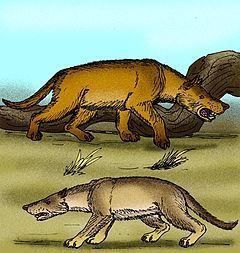Phylum Chordata Rank Family | Order Creodonta | |
 | ||
Lower classifications Hyaenodon, Megistotherium, Apterodon | ||
Creodonts hyaenodontidae
Hyaenodontidae ("hyena teeth") is a family of extinct predatory mammals, and is the type family of the extinct mammalian order Hyaenodonta. Hyaenodontids were important mammalian predators that arose during the late Paleocene and persisted well into the Miocene. They were considerably more widespread and successful than the oxyaenids, the other clade historically considered part of Creodonta.
Contents
General characteristics
Hyaenodontids of Hyaenodontidae are characterized by long skulls, slender jaws, slim bodies, and a plantigrade stance. They generally ranged in size from 30 to 140 cm at the shoulder. While Hyaenodon gigas, the largest Hyaenodon species, was as much as 1.4 m high at the shoulder, 10 feet long and weighed about 500 kg, most were in the 5–15 kg range, equivalent to a mid-sized dog. The anatomy of their skulls show that they had a particularly acute sense of smell, while their teeth were adapted for shearing, rather than crushing.
Because of their size range, it is probable that different species hunted in different ways, which allowed them to fill many different predatory niches. Smaller ones would hunt in packs during the night like wolves, and bigger, fiercer ones would hunt alone during the daylight, using their sheer size and their mighty jaws as their principal weapon. The carnassials in a hyaenodontid are generally the second upper and third lower molars. However, some hyaenodontids possessed as many as three sequential pairs of carnassials or carnassial-like molar teeth in their jaws. Hyaenodontids (like all creodonts) lacked post-carnassial crushing molar teeth (such as those found in many carnivoran families, especially the Canidae and Ursidae), and thus lacked dental versatility for processing any foods other than meat.
Hyaenodontids are very unusual in regards to their tooth replacement. Studies on Hyaenodon show that juveniles took 3–4 years in the last stage of tooth eruption, implying a very long adolescent phase. In North American forms, the first upper premolar erupts before the first upper molar, while European forms show an earlier eruption of the first upper molar.
At least one hyaenodontid lineage, Apterodontinae, was specialised for aquatic, otter-like habits.
Range
Having evolved in Africa during the Paleocene, hyaenodontids soon after spread into India and Europe, implying close biogeographical connections between these areas. Afterwards they dispersed into Asia from either Europe or India, and finally North America.
They were important hypercarnivores in Eurasia, Africa and North America during the Oligocene, but gradually declined, with almost the entire family becoming extinct by the close of the Oligocene. Only four genera, Megistotherium, its sister genera Hyainailouros and Dissopsalis, and the youngest species of Hyaenodon, H. weilini, survived into the Miocene, of which, only Dissopsalis survived long enough to go extinct at the close of the Miocene. Traditionally this has been attributed to competition with carnivorans, but no formal examination of the correlation between the decline of hyaenodontids and the expansion of carnivorans has been reccorded, and the latter may simply have moved into vacant niches after the extinction of hyaenodontid species.
Relations
Hyaenodontids were historically classified in Creodonta, alongside other predatory mammal groups like oxyaenids. Some researchers consider the clade a wastebasket taxon containing two unrelated clades assumed to be closely related to or ancestral to Carnivora. However, a recent phylogenetic analysis of Paleogene mammals supports the monophyly of Creodonta, and places them in Pholidota.
Genera
The Machaeroidinae are sometimes placed here, e.g. by Egi, 2001.
